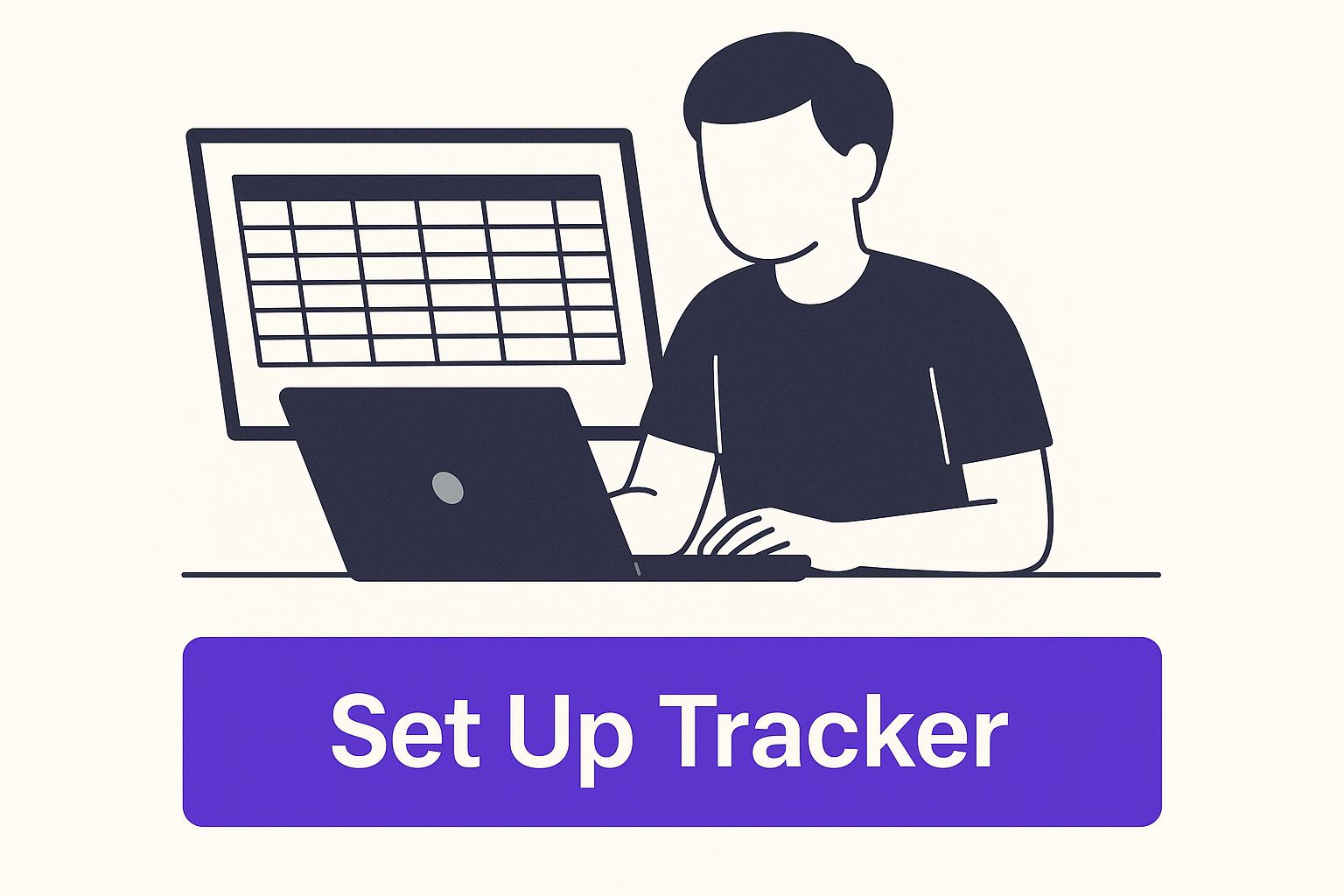Job Search Tracker Guide: Transform Your Career Hunt
Why Your Job Search Feels Like Juggling Fire
Picture this: you have three interviews lined up for next week, but you can’t remember which company wanted to see your portfolio. You've sent out dozens of applications, each with a slightly different resume, and now you're staring at an email from "Chris at Acme Inc." wondering if that was the tech startup or the manufacturing firm.
Sound familiar? This isn't just you; the modern job hunt often feels like juggling flaming torches while riding a unicycle. You're trying to keep track of applications, follow-ups, networking contacts, and custom cover letters, all while keeping your sanity. The sheer volume of information can quickly become overwhelming.
This chaos isn't a personal failure; it's a symptom of a complex process managed with the wrong tools. Relying on scattered browser bookmarks, a messy inbox, and mental notes is like trying to build a house without a blueprint. You might get a wall up here and there, but the structure is shaky and likely to fall apart. This scattered approach actively hurts your chances, leading to missed deadlines, embarrassing mix-ups, and the draining feeling of being perpetually behind.
The Problem of Scale and Competition
The scale of the modern job market only makes this challenge bigger. The global workforce is enormous and continues to grow, with an increase of about 1.4 billion jobs over the last three decades. As of 2025, it includes approximately 3.6 billion employed people. This intense competition means that simply "applying to everything" is a recipe for burnout, not success.
Without a system to manage the details, your efforts become diluted, and valuable opportunities slip through the cracks. This competitive environment is precisely why a job search tracker is an essential tool, not just a nice-to-have.
From Reactive Applicant to Strategic Campaigner
The key to a successful job hunt is shifting from a reactive applicant to a strategic campaigner. A strategic campaigner doesn't just send applications; they track them, analyze what’s working, and adjust their approach. They know which resume version went to which company, when they need to follow up, and what key points were discussed in each conversation.
This level of organization accomplishes several important things:
- Reduces Mental Load: Offloading the tracking from your brain to a system frees up mental energy for what really matters: preparing for interviews and writing great applications.
- Prevents Critical Errors: It stops you from asking a hiring manager a question they already answered or sending the wrong follow-up email.
- Builds Momentum: Seeing your progress laid out visually, even with rejections, creates a sense of forward movement and helps you stay motivated.
By using a simple tracking system, you can transform the chaotic juggling act into a well-orchestrated performance, turning stress into systematic progress.
What Makes a Job Search Tracker Your Secret Weapon
A job search tracker is much more than a simple to-do list or a spreadsheet filled with company names. Imagine it as the mission control for your career search. It's the central hub where every application, networking contact, interview detail, and follow-up reminder comes together in a clear, actionable dashboard. While a basic list tells you what you’ve done, a powerful job search tracker shows you where you’re going and how to get there faster. It helps you move from being a reactive applicant to a strategic career navigator.
This system acts as your personal career intelligence unit. Many large companies use Applicant Tracking Systems (ATS) to filter candidates, and a good tracker lets you mirror this data-driven approach for your own benefit. Instead of guessing, you can see which version of your resume gets more responses or which job boards lead to more interviews. This insight is your competitive advantage, helping you make smarter decisions.
This infographic shows a job seeker setting up their structured tracker, the first step in taking control of their search.

Visualizing the process this way shows how a well-organized system provides a solid foundation for managing multiple opportunities effectively.
From Simple List to Strategic Tool
What really separates a game-changing tracker from a basic spreadsheet? It’s the ability to connect different pieces of information to reveal important patterns. A simple list might remind you to follow up, but a strategic tracker helps you write the perfect follow-up message by linking to your original application, the job description, and notes from your initial conversation. This shift from simple record-keeping to pattern recognition is what gives you real control over your job search.
The Core Components of an Effective Tracker
To be truly useful, a job tracker needs a few key components that work together. Each part has a specific job, turning raw data into information you can actually use.
The table below breaks down the essential elements that every effective job search tracker should have.
| Component | Purpose | Information Tracked | Benefit |
|---|---|---|---|
| Application Log | To maintain a complete record of all submitted applications. | Company, Role Title, Date Applied, Job Source, Salary Range | Prevents duplicate applications and provides a clear overview of your activity. |
| Contact Directory | To manage professional connections for each opportunity. | Hiring Manager, Recruiter Name, Email, LinkedIn Profile | Simplifies networking and makes personalized follow-ups quick and easy. |
| Stage & Status | To monitor the progress of each application through the hiring pipeline. | Applied, Interviewing, Offer, Rejected, Follow-up Needed | Gives you a visual representation of your progress and helps prioritize actions. |
| Document Hub | To store and link relevant files to each application. | Resume Version, Cover Letter, Portfolio Link, Job Description | Ensures you always have the right materials on hand for any conversation or follow-up. |
By bringing these elements together, your tracker becomes more than just a list—it becomes your command center. It frees you from juggling information and allows you to start making calculated, confident career moves that get the attention of employers.
The Hidden Advantages of Strategic Job Search Tracking
Going beyond simple organization, a strategic job search tracker provides powerful insights that can seriously speed up your timeline and improve your results. It's the difference between blindly casting a wide net and fishing with precision sonar. When you methodically track your efforts, you start seeing patterns that would otherwise be invisible, allowing you to fine-tune your approach for the best outcome. This is how your job search shifts from a game of chance to a game of skill.
Uncovering Game-Changing Patterns
Effective tracking shows you which of your strategies are actually paying off. Think of it as A/B testing for your career search. For instance, a marketing professional might notice through their tracker that applications sent on Tuesdays get 40% more responses than those sent on Fridays. An engineer could find that adding a personalized sentence about a company's recent project to their cover letter doubles their interview rate. These aren't just hunches; they are data-driven facts pulled from your own activity.
Without a tracker, these vital details get lost in a mess of sent emails and forgotten applications. With one, you gain the ability to:
- Figure out the most effective job boards or sources for your field.
- Recognize which resume keywords lead to more positive replies.
- Pinpoint the best time of day or week to send in applications.
- Measure how much personalized follow-up emails affect your progress.
Maintaining Motivation and Building Confidence
The job hunt can be a long and emotionally taxing process filled with uncertainty. A tracker gives you tangible proof of your hard work, which is critical for staying motivated. Instead of feeling like you’re going nowhere, you can look at your dashboard and see the 20 tailored applications you sent this week or the three new interviews you’ve booked. Celebrating this real progress, even the small wins, helps you power through the unavoidable rejections.
This organized approach also builds confidence. You go into each interview and application not with desperation, but with the quiet self-assurance of someone who knows exactly where they are and what they're doing next. This is especially important in a tough market. In 2025, while about 30% of the workforce is actively looking for jobs, the other 70% are passive candidates who could be persuaded by the right offer. A well-kept job search tracker gives active seekers the organized advantage needed to manage hundreds of applications and stand out. You can discover more insights about the modern workforce by exploring the latest job search statistics. In the end, tracking gives you the clarity to navigate your search with a clear head and a steady hand.
Building Your Personal Career Command Center
The best job search tracker isn't the most complicated one—it's the one you actually use. Think of it like setting up the cockpit for your career journey. Some people prefer a dashboard full of analog dials (a detailed spreadsheet), while others want a sleek, digital heads-up display (a dedicated app). Your goal is to create a command center that matches your style and shows you the most important information without causing confusion.
Whether you're a recent graduate or a seasoned professional, the principles for creating a great system are the same: start with the essentials and add more detail as you go.

From Spreadsheets to Specialized Apps
The tool you choose will be the foundation of your tracker. Many job seekers begin with a simple spreadsheet, which offers a lot of flexibility. If you're handy with formulas and filters, this can be a powerful, no-cost option. However, entering every detail by hand can become a chore over time. For those starting this way, many modern platforms allow you to easily import spreadsheets and switch to a more automated setup.
On the other hand, dedicated job tracker apps are designed specifically for this task. They often come with built-in features like:
- Kanban boards to see the status of all your applications at a glance.
- Browser extensions to save job postings with a single click.
- Automated reminders for follow-ups and upcoming interviews.
The right choice comes down to your personal workflow. Don't hesitate to try a hybrid approach, maybe using an app for your active applications and a spreadsheet for managing your long-term networking contacts. As you build your command center, remember to apply the top strategies to find remote jobs—your tracker will be key to keeping all those efforts organized.
Structuring Your Tracker: The Essentials Checklist
No matter which tool you pick, a well-organized tracker needs specific fields to be useful. The checklist below will help you set up your system, separating the absolute must-haves from the nice-to-haves.
Job Search Tracker Setup Checklist
A comprehensive checklist of essential fields and features to include in your job search tracking system.
| Category | Essential Fields | Optional Fields | Automation Options |
|---|---|---|---|
| Opportunity Details | Company Name, Job Title, Job ID, Application Date, Job Board Source | Salary Range, Location (Remote/Hybrid/On-site), Company Size | Auto-parsing job details from a URL or browser extension. |
| Progress Tracking | Current Stage (e.g., Applied, Interview 1, Offer), Next Step, Follow-up Date | Rejection Reason, Date of Status Change, Confidence Score | Automatic stage updates based on email integration or manual drag-and-drop. |
| Contact Information | Recruiter Name, Hiring Manager Name, Contact Email | LinkedIn Profile URL, Notes on Rapport, Referral Source | Linking contacts directly to company profiles within the app. |
| Supporting Documents | Link to Job Description, Resume Version Used, Cover Letter Version | Portfolio Link, Writing Samples, Thank-You Note Drafts | One-click linking of documents stored in the cloud (Google Drive, Dropbox). |
When you first set up your tracker, focus only on the essential fields. You can always add the optional columns later as you figure out what information really helps you make better decisions. The idea is to build a system that brings clarity, not more work. A clean and current job search tracker is the engine that will power a focused and successful job hunt.
Preparing Your Job Search Tracker for Tomorrow's Market
The world of work is constantly changing, and the tools we use to find our next role need to keep up. A simple job search tracker that only lists company names and application dates is like trying to navigate a new city with an old, paper map—it’s just not going to cut it. To stay ahead, your tracking system must become more active, helping you anticipate how companies hire and what they truly value.

Adapting to AI-Powered Recruiting and Skills-Based Hiring
Hiring today is heavily influenced by technology. AI-powered recruiting tools are no longer a distant concept; they are here, scanning resumes, assessing candidate fit, and conducting first-round interviews. At the same time, companies are shifting toward skills-based hiring, which puts more weight on what you can do rather than your previous job titles or academic background. This means your tracker needs to capture more than just basic application details.
To make your tracker work for you in this new environment, try adding these new fields:
- Key Skills Match: For every application, identify the top 5-7 skills mentioned in the job description. Then, rate how well your resume highlights these skills. This practice encourages you to tailor each application for the automated systems reading it.
- Application Keywords: Make a note of the exact keywords and phrases used in the job post. As you apply for more roles, you'll start to see patterns, which can help you build a stronger, more effective master resume.
- AI Screening Stage: Create a status to note whether your application has likely passed an initial AI screen. You can often guess this if you receive a quick, automated email or an invitation to a one-way video interview.
This focused approach helps you better align with modern recruitment technology. Getting a peek into the employer's playbook can also give you an edge; understanding the top recruitment strategies they use can inform your own job-seeking tactics.
Tracking New Opportunity Types
The traditional 9-to-5 job isn't the only option on the table anymore. With the growth of the gig economy, project-based work, and portfolio careers, your job search might involve juggling several potential income streams at once. Your tracker needs to be flexible enough to manage this variety.
Consider structuring your job search tracker to handle different kinds of work:
| Opportunity Type | Key Information to Track | Goal of Tracking |
|---|---|---|
| Full-Time Roles | Application Status, Interview Stages, Salary Negotiations | Secure a long-term, stable position with one employer. |
| Contract/Freelance | Project Scope, Proposed Rate, Client Contact, Deadline | Build a steady pipeline of short-to-medium-term projects. |
| Portfolio Projects | Skill Demonstrated, Potential Client, Personal Deadline | Showcase specific talents to attract future clients or job offers. |
This organized method ensures you can pursue a diverse career path without letting any opportunities get lost in the shuffle. The job market is undergoing a major shift. According to the World Economic Forum's report on the future of the job market, it's projected that technological advances and other economic forces will disrupt about 22% of current jobs globally between 2025 and 2030, while also creating 170 million new ones. An updated, forward-looking tracker is your key to navigating these changes. By getting your tracker ready now, you're not just preparing for today's job search—you're setting yourself up for the career landscape of the future.
Avoiding the Tracking Traps That Derail Job Searches
A well-intentioned job search tracker can quickly go from a helpful guide to a source of major stress if you're not careful. It’s a common scenario: even the most organized job seekers can fall into traps that slow down their search and create more work. The real goal is to build a system that supports you, not one that becomes a full-time job in itself.
The most common pitfall is making your system way too complicated. It’s easy to get carried away and build a giant spreadsheet with dozens of columns, tracking everything from the hiring manager's name to the company's quarterly earnings. Think of it like packing for a weekend getaway with three massive suitcases. You spend so much energy managing your luggage that you end up missing the train. Your tracker should make your life simpler, not harder. If you’re spending more time updating your tracker than applying for jobs, that's a red flag to simplify.
The Problem of Vanity Metrics
Another mistake is getting fixated on vanity metrics—numbers that feel impressive but don’t actually help you get a job offer. Sure, tracking that you've sent 100 applications might feel productive, but it says nothing about their quality. Those hundred generic applications are far less valuable than five carefully tailored ones that result in two interviews.
Instead of just counting applications, focus on metrics that show you what's actually effective. Good metrics to track include:
- Application-to-Interview Ratio: How many applications does it take to land one interview? This tells you how well your resume and cover letter are resonating.
- Interview-to-Offer Ratio: This helps you gauge how strong your interview performance is.
- Response Rate by Source: Are you getting more hits from a specific job board, networking events, or direct applications? This shows you where to focus your energy.
Tracking these action-oriented numbers helps you see what works so you can do more of it. It’s a data-driven approach, similar to how companies themselves refine their hiring funnels. If you're curious about how organizations approach this, you can learn how recruiting teams use similar principles on Eztrackr.
Overcoming Tracking Perfectionism
Finally, letting perfectionism take over can bring your job search to a halt. Some people delay applying for great roles because their tracker isn't "perfectly" organized, or they get stuck trying to fill in every single optional field for every application. Remember, a job search tracker is a working tool, not a masterpiece for a museum. It's okay if it's a bit messy. Its purpose is to help you maintain momentum, not to create a flawless historical record.
If you find your system is getting clunky or overwhelming, don’t hesitate to hit the reset button. Delete columns you don't use, archive old applications that are no longer active, and get back to the core information that helps you move forward. A good tracker is functional, not flawless. By sidestepping these common traps, you can ensure your system remains a powerful ally that keeps you organized, focused, and on the path to your next great opportunity.
Transforming Your Job Search Data Into Career Success
Your job search tracker is much more than a digital filing cabinet for applications. Think of it as a personal goldmine of data. Just logging your activity is the first step, but the real advantage comes from analyzing that information. By looking for patterns in your own job search, you can figure out what's working, what isn't, and where to focus your energy for the best results.
This changes your tracker from a simple list into a powerful tool for your career. You stop guessing what employers want and start making smart decisions based on what your own results are telling you.
From Data Points to Actionable Insights
Imagine you're a detective and your job search is the case you need to solve. Every application you log is a clue. Your mission is to connect these clues to find meaningful patterns. For instance, do you get more replies when you apply in the morning? Do resumes with certain keywords lead to more interviews? Answering questions like these can completely reshape your approach.
Here’s a quick look at how a tracker can give you a bird's-eye view of your progress.
This kind of dashboard isn't just a to-do list; it’s a command center. It shows you exactly where each application stands, helping you spot bottlenecks and decide what to do next. If you notice a lot of applications are stuck in the "Applied" column, that's your cue to rethink how you follow up. To turn this data into real success, it's vital to consider every stage, including how to send effective follow-up emails.
Key Metrics to Analyze for a Winning Strategy
To get the most from your data, you need to track the right things. Focus on a few key metrics that directly influence your chances of getting hired.
- Application-to-Interview Rate: This is arguably the most important number at the start of your search. If you’ve sent out 50 applications and only landed one interview, it's a strong signal that your resume or cover letter isn't hitting the mark.
- Source Effectiveness: Where are your best opportunities coming from? By tracking whether leads from LinkedIn, specific job boards, or personal referrals result in more interviews, you'll know exactly where to spend your valuable time.
- Interview Conversion Rate: How many interviews does it take to advance to the next stage or get an offer? Analyzing this helps you identify which interview skills might need some extra practice.
- Response Time by Company Type: Are startups getting back to you faster than large corporations? This simple data point can help you manage your expectations and adjust your follow-up schedule for different kinds of companies.
Beyond the Immediate Search: Long-Term Career Planning
A well-kept job search tracker continues to provide value long after you've accepted a new role. It becomes a living record of your professional network and your understanding of the job market. The contacts you've made, the companies you researched, and the salary data you gathered are priceless assets for your future career growth.
You can return to this information for networking, finding freelance projects, or when you’re ready to make your next career move. This data-first approach builds a solid foundation for continuous professional development.
 Interview Sidekick
Interview Sidekick